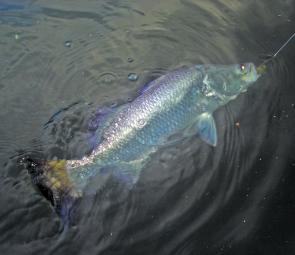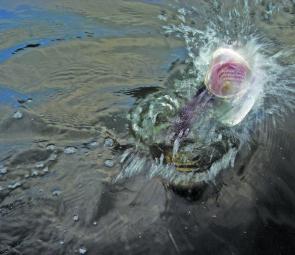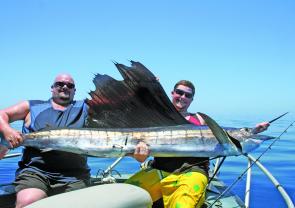Barra is the fish on everyone’s mind come February and this barra season has all the hallmarks of being a beauty. The early onset of the wet has allowed the local barramundi population to do their thing in peace and by now the barra will be widely distributed across their hunting grounds. Anglers have had their appetites wet with continual reports throughout the closed season of barra being accidently caught all over the place. Needless to say, barra fever is high amongst the fishing population around Cairns.
If the river systems have settled by the start of the month (which looks highly unlikely, judging by the long range weather forecasts) then target barra in the snags and rock bars around the estuaries. The afternoon low tide in the first few days of the month will be the best time to reduce the fever, with a bit of lure flicking. For a more sedate approach, drift a live mullet, herring or prawn back into the snags, with the current, and hang on.
If, as I suspect, there is still a lot of fresh in the systems then focus your efforts around the headlands to the south of Trinity Inlet and along Cairns’ Northern Beaches. The barra will be out along the headlands following the bait that has been flushed out by the fresh. Unless you are fishing from a boat, live baiting is rather difficult, so concentrate on luring with deep diving, hard bodied lures in the 10-15cm range, 3” and bigger soft plastics and large Prawnstars. Make sure you are working the lure super slow across the bottom. Expect to get snagged a bit and lose a few lures. If you are not bouncing off the bottom every cast you are not fishing deep enough.
If you have any intention of getting wet then make sure you have protection against marine stingers, which are thick at this time of year. Long pants, long sleeved shirt and shoes, with no skin showing, is a definite must if you feel in any way tempted to unhook that lure snagged just out of reach.
Daylight and dusk are by far the best times, so if you are not arriving under torch light or departing in the dark, then your timing is too late or too early respectively. Time of tide is not as important as the time of day along the headlands but if you can combine a low tide with dawn and dusk (the few days after the new and full moons) you will significantly improve your chances. Generally speaking, there needs to be fairly calm conditions and the water relatively clear, but not crystal clear, to do well. Barra being the mystery fish they are, however, don’t always play by the rules. I have caught barra along the headlands in brown soup and also when the swell is a metre high. They are one fish that consistently bites during the major and minor bite times indicated in the Angler’s Almanac. So lash out and spend $6.60 to get the 2011 edition. It is the best value for money investment you can make into fishing.
If there is still a fair bit of freshwater runoff, then focus on the drains and small creeks that flow into bigger streams. This method of attack is far easier from a watercraft of some type. A tinnie, canoe or kayak is ideal. Canoes and kayaks are not as popular in the north as down in the south east corner, due to the threat of crocs, but I have been luring from canoes for years and never had a problem from our saurian neighbours. – touch wood!
Luring or live baiting will do the trick, with the state of the water flow the most important ingredient in this approach, more so than the time of day. If fishing the fresh, then timing the session to coincide with the runoff is a real challenge. You need to be there as the water levels drop and the small streams start to drain into the main system, bringing with it the bait that barra are waiting for. In an estuary situation it is a bit easier, as each falling tide will have that runoff period and it is just a matter of getting the timing right, to be there as it first starts.
There are always a few jacks and fingermark around at this time of year, so if the streams are clear, target jacks in the snags and rocks and fingermark in the deeper structure. While jacks willingly take fresh strip or whole baits, fingermark are fussier and are almost exclusively live bait takers in the Cairns area. Live mud herring, sardines, mullet, whiting, squid or prawns, on a dropper rig, will always put you in with a chance at one of these premier fish. If there is still plenty of fresh around then the fingermark will be on the headlands and around the inshore islands and reefs. They don’t like fresh water and move out of the estuaries when it floods.
There are offshore options in February, but it tends to be pretty hot during the day at the reef, so time your trip for the cooler parts of the day. Travelling any distance during the night can be hazardous at this time of year, due to floating debris washed out by the floods, so please take care. Fishing at the reef in February is generally a real mixed bag, with a sprinkling of all and any species. There are few runs of any particular species, except possibly red throat sweetlip, if there has been a cyclone. Red throat are an irregular visitor to the reefs off Cairns but often show up in big numbers after a cyclone. Otherwise it’s a matter of trying different depths to determine where the fish are feeding. Once you have determined the depth, it’s simply a matter of moving as the bite dies off at each spot. If after half and hour there hasn’t been a keeper come aboard, then it’s time for a shift.
There will also be the odd mackerel hanging around the wrecks and reefs, so it’s always worth having a floating bait out. The good old pillie set at about three metres, under a float, is surprisingly consistent at picking off a Spaniard or other top water fish.
Reads: 2503
Barra fever can only be controlled but never cured. A site like this helps sooth the symptoms.

A barra leaving the water to try and dislodge a lure usually has the opposite effect and simply heightens barra fever.

Jamie Grattidge, from Melbourne, came to Cairns with his father, who paid for the fishing trip for his 21st birthday. They hoped to tangle with a marlin or sailfish and Jamie was absolutely stoked to land this 2.90m beauty when fishing with Blackout Sport




